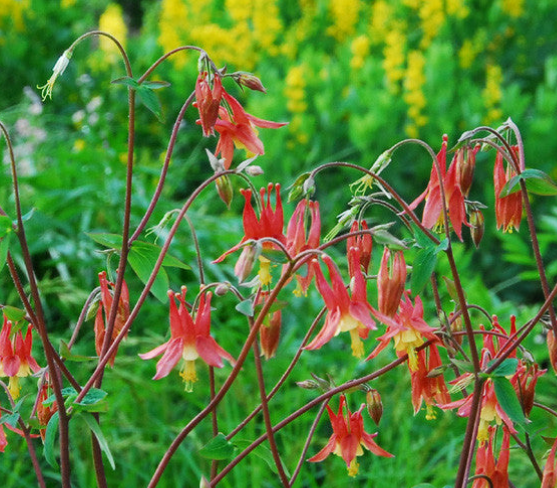- 2024 Native Trees
- >
- Herbaceous Plants
- >
- Red Columbine (Aquilegia canadensis)
Red Columbine (Aquilegia canadensis)
Height: 1 to 2 feet
Bloom Time: April to July
Bloom Description: Red
Sun: Prefers part shade, but will tolerate full sun to full shade
Attracts: Pollinators and birds, including hummingbirds
Buttercup Family
Native to Jefferson County
Red Columbine, also known as Wild Columbine, is one of the first wildflowers of spring, blooming as early as April. Aquilae, the Latin word for “eagle” refers to the way the flowers resemble eagle talons. The drooping red tubular flowers are pollinated by hummingbirds, which depend on the plant as an important early nectar source. Long-tongued insects are also attracted to red columbine, however, bumblebees often “cheat” their pollination duties by piercing the flower and stealing the nectar.
Red Columbine is found naturally in rich woods, but can also be found on wooded to open rocky ledges and hillsides. It has a preference for slightly acidic soil that is moist in spring and dries out in summer, although it will tolerate varied degrees of moisture and fertility.
It is popular in native landscapes because of its hardiness and the fact that it is readily regenerated by seed. It is a useful plant for woodland and meadow plantings. A drawback for some gardeners is that the plants are short-lived (3 to 5 years) and have a habit of moving about the garden because of their tendency to reseed. Other gardeners find a random Red Columbine popping up in a rock wall to be a pleasant surprise.
Thomas Mann Randolph, Thomas Jefferson's son-in-law, observed this perennial wildflower blooming on April 30, 1791, at Monticello. Jefferson may have sowed seed in the gardens.
In addition to hummingbirds seeking out the flower nectar, Red Columbine is an attractant for songbirds including sparrows, waxwings, vireos, wood warblers, orioles, mockingbirds and thrashers. In addition to its attractiveness to pollinating insects, 11 species of butterflies and moths use Red Columbine as a caterpillar host plant. ■






